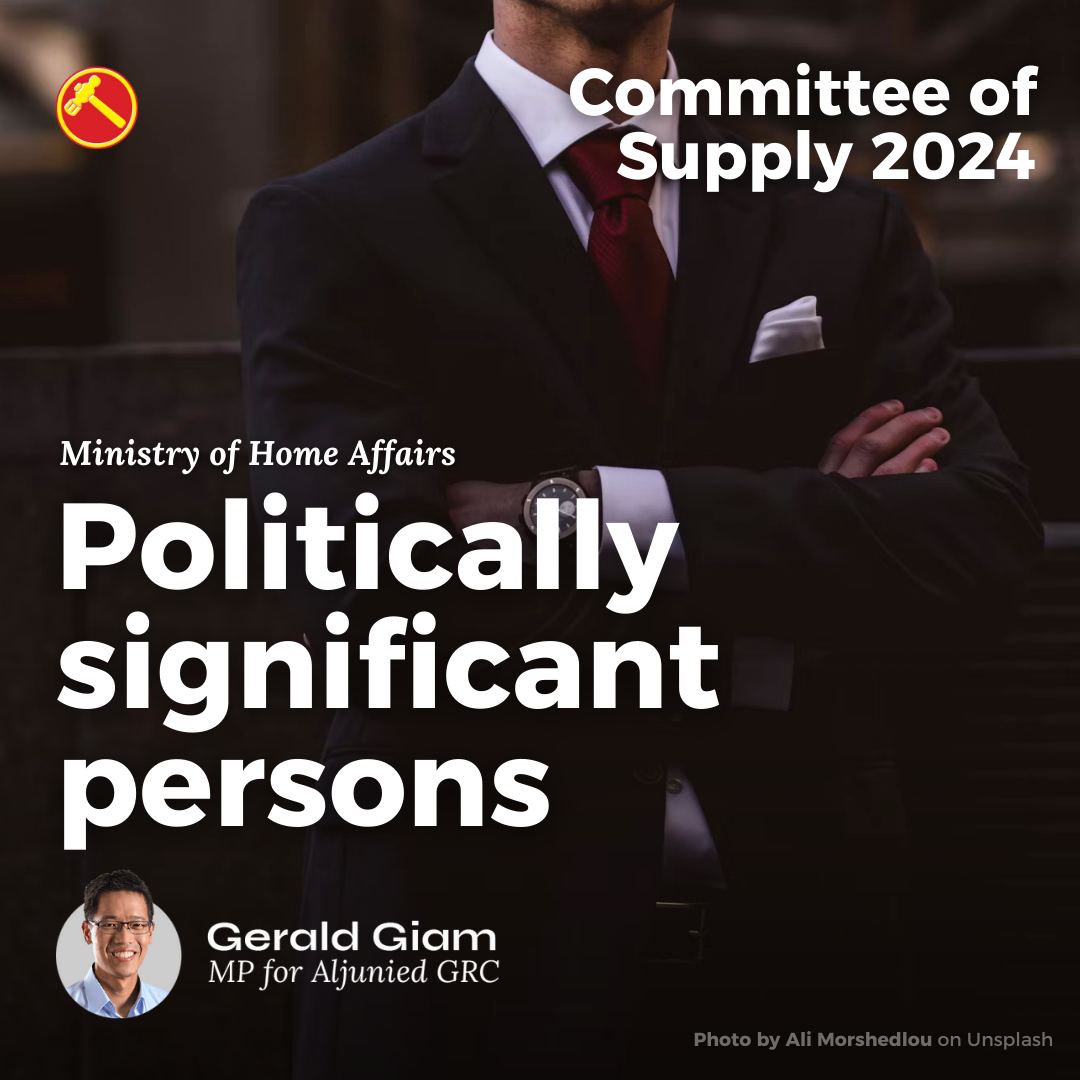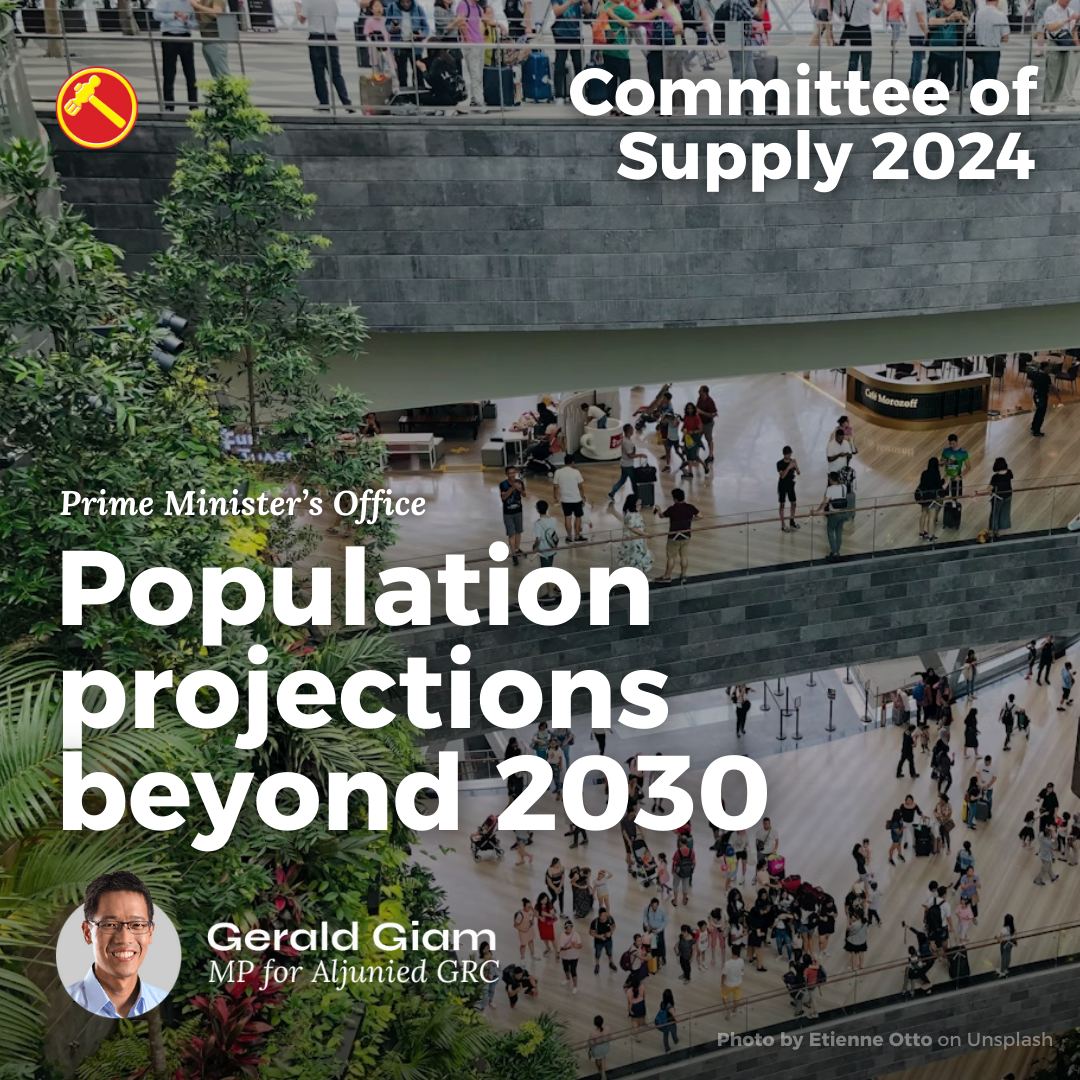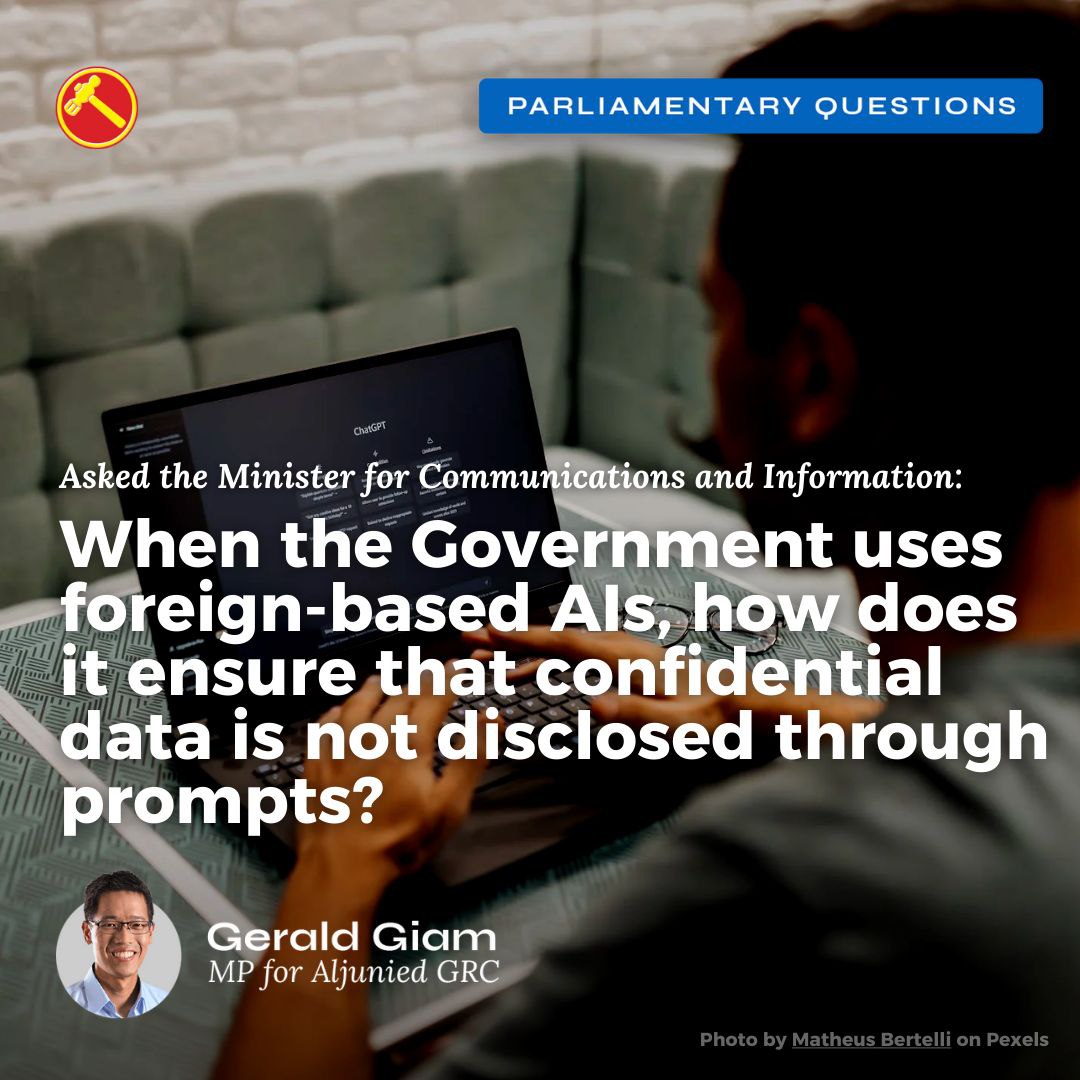5 Feb 2024, Parliament
The government unveiled its National AI Strategy 2.0 report (NAIS 2.0) last December. The report outlines Singapore’s plans to harness artificial intelligence (AI) for the public good, focusing on enhancing AI capabilities, addressing potential risks and fostering a thriving AI ecosystem.
I appreciate the hard work that many policymakers have put into writing this report, including their efforts to consult with industry.
However, I believe that Singapore needs a more comprehensive AI industrial policy and clearer outcomes for each industry. We need a strategy that aims to make our nation the global leader in selected AI fields.
Under NAIS 2.0, the government’s main role revolves around enabling an environment for AI to grow and enhancing the efficiency of public agencies. While these are important, the government certainly has the resources and capability to do much more. In this AI-driven era, we need the government to intercede more proactively to create a world-leading AI industry. Simply leaving things to the free market may not produce the desired results because of the constraints of our local private sector and our small domestic market. It will risk forfeiting some promising economic growth opportunities that AI can bring for our nation.
Singapore’s small population should not deter us from global AI leadership. Historical industrial successes have been built on strategic government interventions, such as Taiwan’s support of TSMC, which played a pivotal role in its journey to becoming a global semiconductor manufacturing juggernaut.
Today, I will address NAIS 2.0’s AI labour policy and advocate for a strong AI industrial policy so that Singapore can aim for global leadership in selected AI domains.
AI labour policy
Let’s begin with the AI labour policy. The goal in NAIS 2.0 to generate 15,000 AI jobs sparked a blend of enthusiasm and apprehension among Singaporeans. Concerns linger that, as has happened in the past, foreigners may dominate lucrative positions — including leadership positions — leaving Singaporeans with mainly the routine and lower-paying jobs. This could impede our citizens’ career advancement alongside the advancing AI landscape.
NAIS 2.0 has three labour planks. Scaling up AI-specific training programmes; scaling up technology and AI talent pipelines; and remaining open to global tech talent.
Will the government commit to ensuring that a sizable majority of at least two-thirds of the 15,000 new “AI practitioner” jobs will go to Singaporeans?
I acknowledge the importance of global AI talent. However, there must be a clear differentiation between exceptional global talent and the average foreign tech worker. We should welcome the former, but should avoid importing too many of the latter, as they may end up competing with Singaporeans who can do the job just as well. Any global talent that we bring in must be expected to transfer their skills to locals, not just use Singapore as a springboard for greater pursuits in other countries. This can be done through tying company grants to the achievement of knowledge transfer, or through limited-term foreign work passes tied to the training of Singaporean workers.
The AI playground is level, with a highly collaborative open-source community. The core techniques and frameworks are mature enough and reasonably accessible through papers and code. With the right training, mentorship and opportunities, Singaporean talent can deliver as well as anyone in the world.
To raise a body of local AI talent, AI-training programme places and talent pipelines must be focused on Singaporeans. We need to plan ahead and start training all our students early in AI — not just students who are academically strong in the sciences and mathematics.
For mid-career workers, hands-on interaction with AI tools is one of the best forms of training. The government should expand the scope of SkillsFuture Credits to cover expenses for subscriptions to AI assistants like ChatGPT Plus or Github Co-pilot to accelerate their productivity. This will level the playing field for Singaporeans with less means to pay for such subscriptions. Paid models like GPT-4 have been assessed to be significantly better than their free counterparts, and we should give our workers more opportunities to use the best models.
Moonshots in industry
Next, on industry. It was once unclear if it were possible for humans to reach the moon. But US President John F. Kennedy made a speech to Congress in 1961, rallying his nation to achieve the goal of landing a man on the moon and returning him safely to Earth before the end of that decade. And NASA’s Apollo 11 mission achieved it ahead of schedule on 20 July 1969.
A “moonshot” is an ambitious, exploratory and groundbreaking target that has the possibility of spurring breakout growth. We need moonshots in AI, which NAIS 2.0 appears to lack.
The government has the resources and capacity to take on more risks on a longer timescale to pursue high-reward moonshots. These could catalyse future engines of growth. But first, the government must catch the vision and have the determination to make our country number one in our chosen AI domains.
Achieving some of these AI moonshots has implications on our economic security and even our sovereignty.
Advances in AI rely on large, high-quality data sets. We must ensure that foreign tech firms and governments do not end up extracting our data overseas to build AI products, which then get sold back to Singaporeans. This will allow such firms to profit immensely while local expertise flounders.
Currently no global framework governs cross-border data flows and ownership. This allows predatory dynamics to continue between countries and companies. Once market dominance is achieved, network effects and the dynamics of chasing a moving target make it almost impossible for new entrants to catch up.
If we are not careful, Singapore may become only a consumer of such platforms, while the economic benefits and the best jobs go overseas. Singapore should avoid this by proactively building comprehensive local data sets for homegrown AI development.
Management of moonshots
We should pursue a few ambitious, publicly-funded moonshot projects. These projects must prioritise transparency and align their outcomes with the national interest, ensuring that economic gains directly benefit our citizens.
A new government-owned AI startup will be needed to catalyse this moonshot, and I will refer to it as the AI Catalyst Corporation. It should be independently run with commercial dynamism, yet be ultimately answerable to Singaporeans.
What constitutes a well-chosen moonshot? I would like to propose five key principles:
First, its products or services must directly benefit Singapore and Singaporeans. Second, it should have export potential and become part of Singapore’s economic growth engine.
Third, it needs to have “moats” — which are durable advantages to prevent it from being quickly outcompeted or swallowed up by global tech giants.
Fourth, there must be a genuine unmet global market gap that Singapore has advantages in tackling. And fifth, the industry should be ripe for fundamental disruption, not just incremental improvements.
Healthcare AI as a moonshot
Healthcare AI could be a moonshot that Singapore can aim for. I will present the case for this, and answer the five questions in reverse order.
Is healthcare ripe for fundamental disruption? Yes. Healthcare systems worldwide are under strain due to ageing populations and chronic disease burdens. Healthcare institutions tend to treat diseases late in their course, when symptoms are severe and care is expensive. Yet major conditions like obesity, heart disease and cancer, are driven by shared underlying factors. This outdated care model no longer aligns well with scientific reality. Healthcare AI, supported by population-scale data, has the potential to predict risks and intervene early to significantly improve health outcomes.
This will require a reorganisation of healthcare delivery that focuses on early prevention and action. Singapore has started this journey through the Healthier SG programme. Let’s turbocharge it with healthcare AI.
Second, is there a genuine unmet global market gap? Yes. Electronic health record (EHR) systems remain fragmented worldwide. Even in the US, no dominant player exists in healthcare AI. The players are fragmented among various entities like EHR providers, tech firms, life sciences companies, insurers and hospitals. Those with vast healthcare data may not have efficient AI models, and vice-versa.
Singapore, on the other hand, has a unique opportunity to build a population-scale healthcare data ecosystem tailored for AI. We can more easily overcome the coordination challenges that may oblige larger ecosystems to build healthcare AI components in a piecemeal fashion. A platform called MOH TRUST already aggregates multiple healthcare research datasets, and the National Electronic Health Records (NEHR) system aggregates clinical data across Singapore. So the government is already collecting and coordinating healthcare data. What is missing is the impetus to use this data to drive the future of AI through an industrial policy.
Third, are there “moats” against global tech giants? Yes. Healthcare AI depends a lot on having local healthcare teams and physical sensors to collect and manage clinical data. AI can serve as an assistant to local healthcare workers and give Singapore an edge over others. Singapore has already signalled its commitment to generating comprehensive data, like in the SG100K genome study. Healthcare also has more durable data moats than other AI spheres like linguistics, where SEA-LION’s defences against global tech giants in low-resource languages is uncertain.
Fourth, does healthcare have export potential? Yes, as a public good, healthcare AI can benefit other countries while facing fewer sovereignty concerns. Debates are taking place globally about where large AI systems are trained and deployed. However AI, when used for healthcare, which can potentially benefit everyone, is less likely to attract controversies or nationalist and protectionist tendencies.
By assuming a leadership role in this field, Singapore can export our healthcare AI innovations, generate much international goodwill and even use this to advance our foreign policy.
And finally, does it benefit Singaporeans? Yes, through improved public health, economic growth and global technological leadership.
Singapore has other comparative advantages in the race for global leadership in healthcare AI. We have a robust healthcare system, the SingPass digital ID, cross-domain talent and a history of government investments and interventions in specific industries.
Singapore’s demographic diversity provides rich healthcare data across ethnicities and ages. Healthcare AI can catalyse the development of adjacent fields like computational genomics and precision medicine.
Singapore has the ingredients for a breakthrough in Healthcare AI. To succeed, the government needs to take the lead in putting these ingredients together.
What should we do in Healthcare AI?
To realise a healthcare AI moonshot, Singapore must combine existing ingredients into a coherent strategy. We should aim to export specialised services and medical diagnoses, not raw data.
We can create an advanced AI model trained on genetics, protein biomarkers, histology and electronic health records. We should aim to radically improve our ability to prevent disease, intervene and make causal inferences.
A multi-modal healthcare AI foundation model moves beyond narrowly specified “point-solutions”. By having a single foundation model for, say, both chest X-rays and retinal image interpretation, we can overcome data fragmentation across medical specialties and make it increasingly possible to uncover foundational principles of diseases.
As for electronic health records, the NEHR system is valuable, but it needs to be AI-ready in order to consolidate complex datasets such as histology imaging, genetic data or protein data. We should create comprehensive longitudinal patient histories spanning years. Existing data needs to be sufficiently standardised to serve AI analysis without a massive amount of preprocessing.
An AI Healthcare Company under the AI Catalyst Corporation could drive this moonshot. This AI Healthcare Company needs its own versatile multi-modal foundation model integrated with the NEHR. This will enable large-scale analysis to identify at-risk groups, conduct preventative screening and perform early treatment. It will also enable high-quality acute care, as a simultaneous expert in genomics, biology, general medicine and the specialties.
The AI Healthcare Company could build the world’s best multi-modal healthcare AI and healthcare dataset. This could establish an unmatched resource — built in Singapore, for the world.
Local AI startups can also benefit from this foundation model to build their own applications to sell to the world.
Just like how OpenAI’s access to ChatGPT queries provides unmatched data for improving their future large language models, the first company to create a versatile multi-modal healthcare foundation model would likely find itself at the frontier of healthcare AI.
Conclusion
Mr Speaker, in conclusion, a healthcare AI moonshot strategy will position Singapore as a global leader in AI by leveraging our unique capabilities in consolidating biomedical and healthcare data. It is a national approach designed to secure data sovereignty, navigate data-privacy concerns, ensure Singapore captures the benefits of AI, and maximise public by-in. This isn’t about picking winners; it is a proactive strategy to ensure Singapore thrives in the AI-driven future to benefit all Singaporeans.
I have presented just one example of a moonshot that Singapore could pursue. There may be other moonshots of equal or greater merit. I welcome open debate on selecting moonshots, but we cannot pull our punches if AI is truly the new industrial revolution.
Singapore possesses the talent, resources and infrastructure needed to compete for the top spot in selected AI fields. Achieving it requires political will, a readiness to embrace risks and proactive intervention by the government. We can do it, and we must do it, for the benefit of Singapore and Singaporeans.








